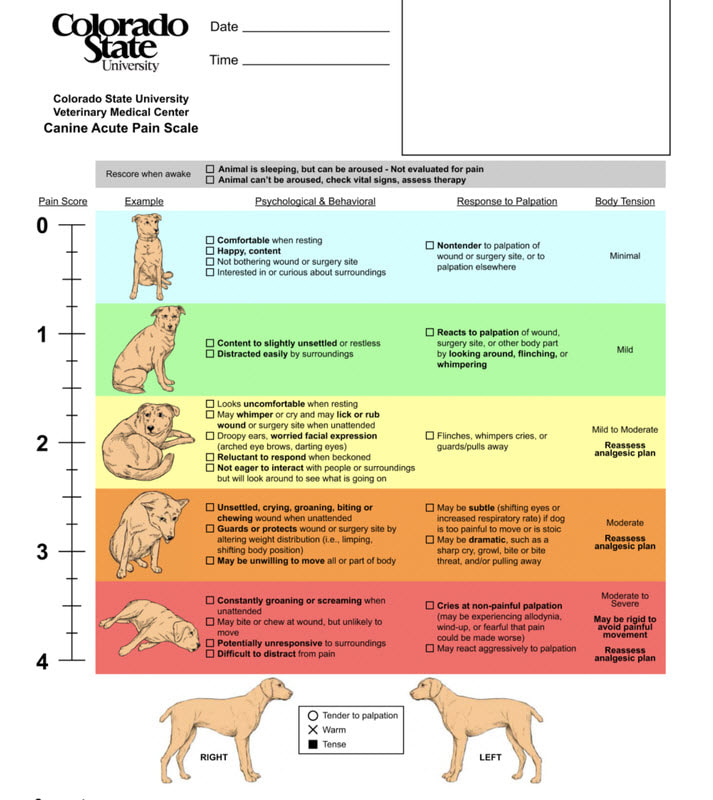| The big problem with identifying pain in dogs is twofold. Firstly, dogs hide pain well. Secondly, they can’t tell us when they are in pain much like infants and small children. It is up to the dog owner to monitor their actions and body language for clues as to how they are feeling, whether it is about their fears, and interactions with people, and other animals or even pain. Certain things that cause pain can be easily identified; open wounds, broken bones, etc. Stop and think about your own experiences with pain. Would anyone know you are in pain if you didn’t tell them? Think about issues like:
|
In human medicine, 80% of diagnoses are made via a clinical exam [http://jamanetwork.com/journals/jamainternalmedicine/fullarticle/1105870], which involves obtaining an in-depth description from the patient of their symptoms. If you are in pain, you will be asked to rate your pain on a scale of 0-10 or bases on a facial expression scale.
Dogs don’t have the ability to verbally give us this information so we often have to use our own observation skills and our knowledge of our dogs to work out if our dog could be in pain. Veterinarians now have a way to apply the same type of pain scale from human healthcare to our pets. Colorado State University has developed a Canine Acute Pain scale (there is also a Feline version) to help categorize and standardize pain assessment.
Pain is subjective and still difficult to measure. It is not uncommon for two dogs to have the same injuries and while one dog will happily wag its tail and act like nothing is wrong, the other will cry in panic and pain.
Any medical or illness that causes pain, discomfort or decreased mobility, such as arthritis, dental disease, hypothyroidism, cancer, impaired sight or hearing, or Cushing’s disease, can lead to increased sensitivity and irritability. There can also be increased anxiety about being touched or approached, decreased responsiveness to commands, reduced ability to adapt to change and an increase in aggression; your dog may choose warn and bite rather than move away.
If your dogs’ behavior changes, they maybe communicating to you that they are in pain.
Dogs don’t have the ability to verbally give us this information so we often have to use our own observation skills and our knowledge of our dogs to work out if our dog could be in pain. Veterinarians now have a way to apply the same type of pain scale from human healthcare to our pets. Colorado State University has developed a Canine Acute Pain scale (there is also a Feline version) to help categorize and standardize pain assessment.
Pain is subjective and still difficult to measure. It is not uncommon for two dogs to have the same injuries and while one dog will happily wag its tail and act like nothing is wrong, the other will cry in panic and pain.
Any medical or illness that causes pain, discomfort or decreased mobility, such as arthritis, dental disease, hypothyroidism, cancer, impaired sight or hearing, or Cushing’s disease, can lead to increased sensitivity and irritability. There can also be increased anxiety about being touched or approached, decreased responsiveness to commands, reduced ability to adapt to change and an increase in aggression; your dog may choose warn and bite rather than move away.
If your dogs’ behavior changes, they maybe communicating to you that they are in pain.


 RSS Feed
RSS Feed